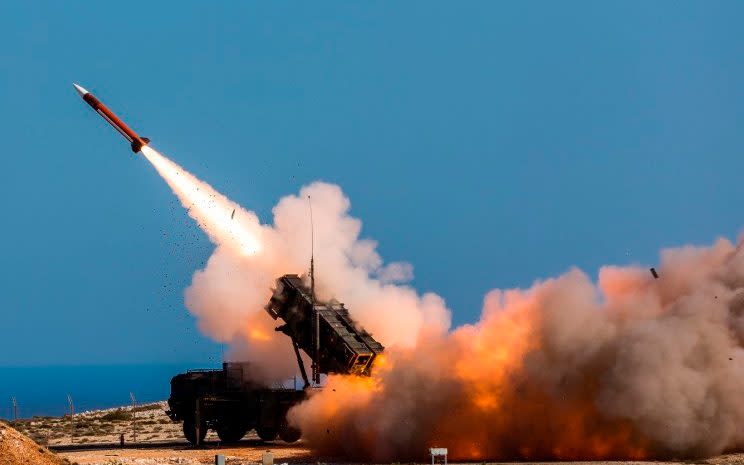Ukraine’s missile battle has transformed the image of America’s Patriot interceptor

- Oops!Something went wrong.Please try again later.
The Patriot surface-to-air missile has been the U.S. military’s main ground-based air-defense system for more than 40 years. But for most of those four decades, the trailer-mounted Patriot – a product of Virginia-based Raytheon – had, at best, a mixed reputation.
Some Americans combat pilots even feared misaimed Patriots almost as much as they feared the enemy’s own air-defenses: one US pilot actually shot at a Patriot battery and blew up its radar.
But then the United States, Germany and The Netherlands donated surplus Patriot batteries – each with a radar and several launchers – to Ukraine to help defend against Russian air and missile attacks. And in a single daring operation last month, the Ukrainians largely redeemed the beleaguered missile system.
Ukraine’s success with the Patriot has implications not only for that country’s war effort. It could also weigh on U.S. and allied plans for a potentially much bigger conflict: a clash with China over Taiwan.
The Patriot entered service with the U.S. Army in 1981, but it wasn’t until 10 years later that it saw combat for the first time – over Kuwait and Iraq during Operation Desert Storm. On 47 occasions, Patriot batteries fired missiles at what their operators believed were incoming Iraqi Scud ballistic missiles.
The Pentagon claimed the Patriots shot down most of the Iraqi rockets. A year later, however, Massachusetts Institute of Technology scientist Ted Postol analyzed videos of most of the alleged shoot-downs and arrived at a startling conclusion. “We found no convincing evidence in the video that any Scud warhead was destroyed by a Patriot,” Postol told a U.S. House of Representatives committee. It should be borne in mind that Postol has spent much of his career trying to make sure that the U.S. doesn’t build ballistic missile defences, so he would never be likely to say anything good about the Patriot, but even so his criticism had a powerful effect.
The U.S.-led invasion of Iraq in March 2003 did little to redeem the Patriot’s reputation, even after Raytheon had spent 12 years upgrading the SAM system. As American and coalition forces swept into Iraq, scores of Patriot launchers followed behind them, maintaining a continuous air-defense screen just behind the front line.
But the Patriot batteries struggled to tell friendly aircraft from enemy ones. In separate incidents, Patriot crews accidentally shot down a Royal Air Force Tornado fighter-bomber and a U.S. Navy F/A-18, killing the three crew. Other coalition pilots were forced to take evasive action after friendly Patriot batteries locked onto them.
“The Patriots scared the Hell out of us,” one U.S. Air Force F-16 pilot remarked. Tensions boiled over when another F-16 pilot, hounded by an out-of-control Patriot battery, actually fired a missile at the battery’s radar – and knocked it out of action. ‘v’
The 2003 war was a black mark on the Patriot’s already spotty reputation. It didn’t help when, in March 2018, Saudi Patriots failed to intercept a barrage of rockets fired from Yemen by Houthi rebels. “It’s nothing but an unbroken trail of disasters with this weapon system,” Postol said at the time.
Which is why expectations were low among many missile experts when Ukraine began acquiring surplus Patriots in order to replace its dwindling stock of leftover Soviet air-defense missiles. But then Ukrainian SAM crews surprised everyone – and perhaps saved the Patriot from looming irrelevance.
In a daring missile ambush on May 13, Ukrainian Patriots firing from secret positions near Ukraine’s northern border with Russia apparently shot down four Russian aircraft – Su-34 and Su-35 fighters and two Mi-8 helicopters – as far as 30 miles inside Russia’s Bryansk Oblast, all in the span of just a few hours.
The back-to-back shoot-downs marked one of the worst single-day losses of the current war for Russian squadrons. “Thank you, USA, for our beloved Patriots!” the Ukrainian defense ministry tweeted a few days later, after its Patriots bagged a clutch of Russian drones and cruise missiles.
It’s not totally clear why the Patriots have worked for Ukraine when they didn’t work for the United States and Saudi Arabia. Raytheon has continued to upgrade the system’s missiles and software, of course. And it’s worth noting that, after 15 months of hard fighting, Ukrainian air-defense crews are some of the most experienced in the world.
The abrupt reversal in the Patriot’s fortunes is welcome news for the United States, as well as for dozens of other countries that still rely on the system for their air-defense. They include Taiwan, which operates seven Patriot batteries – and is counting on them to blunt attacks by potentially hundreds of Chinese warplanes and missiles in the event China makes good on its threats and invades the island democracy.
Taiwanese planners don’t expect their air-defenses to win the war, of course – or even to survive it. The plan is for Taiwan’s Patriots and other SAMs to buy time for American reinforcements to arrive. The longer the Patriots last, and the more Chinese targets they hit in the meantime, the greater the chance the Americans might deploy in sufficient numbers to turn the tide of battle.
Taiwan isn’t Ukraine, of course – and China isn’t Russia. But if the Patriot works in the sky over Ukraine and Russia, it could also work in the sky over Taiwan. Finally.

